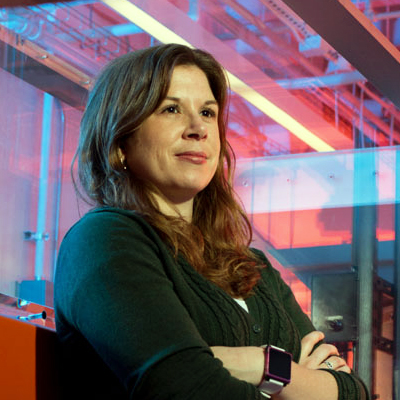How fluid dynamics is propelling energy applications
When you drag an oar through the water, whirling vortices form at the edges, created by the difference in pressure in front of and behind the oar surface. The pressure difference creates the force you feel in the handle of the oar, the aerodynamic drag generated as you literally drag yourself across the river. Dr. Melissa Green, Assistant Professor of Mechanical and Aerospace Engineering at Syracuse University, studies the basic physical mechanisms of unsteady fluid flow around drag-producing bodies, like stationary paddles or posts, or flapping wings and fins. The generated drag force is directly related to the vortex structures that appear in the flow around the body, and Green’s group studies how to design engineering applications to either create the force more efficiently (say, out of an oar stroke), or to mitigate the force as much as possible (as on a stationary structure in a current). Her work will help save energy for a variety of vehicles, and secure the safety of structures that are susceptible to fluid forces, like buildings and bridges.
In one project, Green and her lab investigate the vortex wakes created by the flapping of aquatic animal fins and flukes as a possible model of man-made underwater propulsion. While the researchers in the Green Fluid Dynamics Lab look at simple materials like plastic to create simple fin models, a collaboration with the Director of the Syracuse Biomaterials Institute collaboration also enables them to incorporate flexible bio-inspired materials that can actually resemble the bending and surface feel of a real fish fin. Uniquely equipped with expertise in measuring and visualizing fluid flows experimentally and visualizing data in order to create a thorough description of three-dimensional unsteady dynamics, Green and her lab hope to help address important energy efficiency applications.
Current research includes:
• Bio-inspired Swimming: The vortices that Green identifies and tracks in the wakes of model fins and wings represent the coherent motions or patterns in the flow, which are related to mass transport, force, and pressure. In water channel experiments, Green and her research group use flapping fish-like models to investigate the vortex structures in the wake they leave behind. Depending on how fast a fin flaps, or the size of a wing, different patterns of vortices emerge in a wake that can correspond to either more efficient or more powerful propulsion. Green’s experiments will explore the contribution of each design component to the pattern formation, which can then inform design of vehicle geometry and its propulsive motion. The full 3D organization of flow fields that Green is able to visualize with her water channel experiments provides valuable information as to how some marine animals like fish, dolphins, and whales are swimming with such high efficiency, power, and maneuverability. Her research group and others will be able to use this knowledge to design vehicles that can perform a range of missions using less energy and creating less disruption to the natural environment.
• Fundamental Bluff Body Shedding: Green’s lab also studies the canonical problem of vortex shedding -- a physical process that can generate large magnitude unsteady forces in a host of engineering applications. Particularly, Green studies the oscillating forces on stationary cylindrical bodies found in vehicle cables, struts, or bridge supports. Green’s research group has novel ways of describing changes in the flow field that are associated with the oscillating forces, and they are working on ways to detect them on the fly in active flow control schemes that would mitigate these forces.
• Large-scale Turbulent Flame Interaction for Combustion: Using the same analysis tools that they use in low speed swimming flow applications, Green and her students are looking at full scale turbulent flame interactions. One of the hallmarks of turbulence is that both large and small scale phenomena are important, and that it is difficult to simulate both at the same time. By letting the turbulence interact with a chemically reacting flow, the complexity increases dramatically. Moreover, the dynamic relationship between turbulent vortex structures and a chemically reacting flame has been shown to change with an increase in the intensity of the turbulence. By studying the basic mechanisms of the interaction, Green and her lab are effectively researching different ways to “design” the turbulent flow in order to have the most efficient mixing in combustion applications.

Bio
Dr. Melissa A. Green is an assistant professor of Mechanical and Aerospace Engineering at Syracuse University. She received her B.S. in Aerospace Engineering from the University of Notre Dame in May 2003, and her Ph.D. from Princeton University in March 2009. She was awarded an NAS/NRC Postdoctoral Research Associateship to work with the Laboratories for Computational Physics and Fluid Dynamics at the Naval Research Laboratory in Washington, DC. She began her tenure track position at Syracuse University in January 2012, and in 2014 received the Air Force Office of Scientific Research Young Investigator Award to study vortex dynamics in bluff body shedding flows. Green uses experimental methods such as surface pressure measurements, flow visualization, and digital particle image velocimetry in conjunction with a broad range of data analysis tools. Green and her students employ the method of Lagrangian coherent structures, in particular, to identify and describe vortex phenomena such as vortex shedding and breakdown.
When she was 14, Green was sure she wanted to be a marine biologist because she loved watching marine animals swim -- sharks in particular. After her high school biology course, however, she realized that memorization of taxa were not for her, and she was never going to pull off a Biology major. Instead, she followed her knack for solving problems into a Mechanical and Aerospace Engineering program. She didn’t immediately make the connection when she was drawn to courses in fluid mechanics, but eventually jumped at the chance to study bio-inspired swimming in a Ph.D. program after graduation. Without looking for it, she had found her “back door” into marine biology.
From that point on, Green stayed in academia because she enjoyed the community of people who chase problems that interest them, and who self-direct research programs based on those passions and interests. Although she has been known to say that she “didn’t get into this for the teaching,” she has also found that mentoring and interacting with undergraduate and graduate students has become one of the most rewarding parts of being a faculty member. She tries to foment advising relationships that are as constructive and valuable as she has enjoyed in her career so far.
Outside of research, Green spends her time trying to convince her husband to add yet another shelter animal to their family. She’s relatively certain that the two cats and the pitbull mix are lonely. The animals themselves had no comment (although they’re pretty sure it’s time for dinner).
For more information, visit greenfluids.syr.edu. For related research news and the occasional cat photo, follow Dr. Green at www.instagram.com/greenfluids or www.twitter.com/SUProfGreen.
In the News
Syracuse University Engineering & Computer Science
Syracuse University
Syracuse University
Publications
Videos
Awards
The Filtertech, Pi Tau Sigma, and Sigma Gamma Tau Award for Excellence in Education in Mechanical an Aerospace Engineering, 2015
Syracuse University


